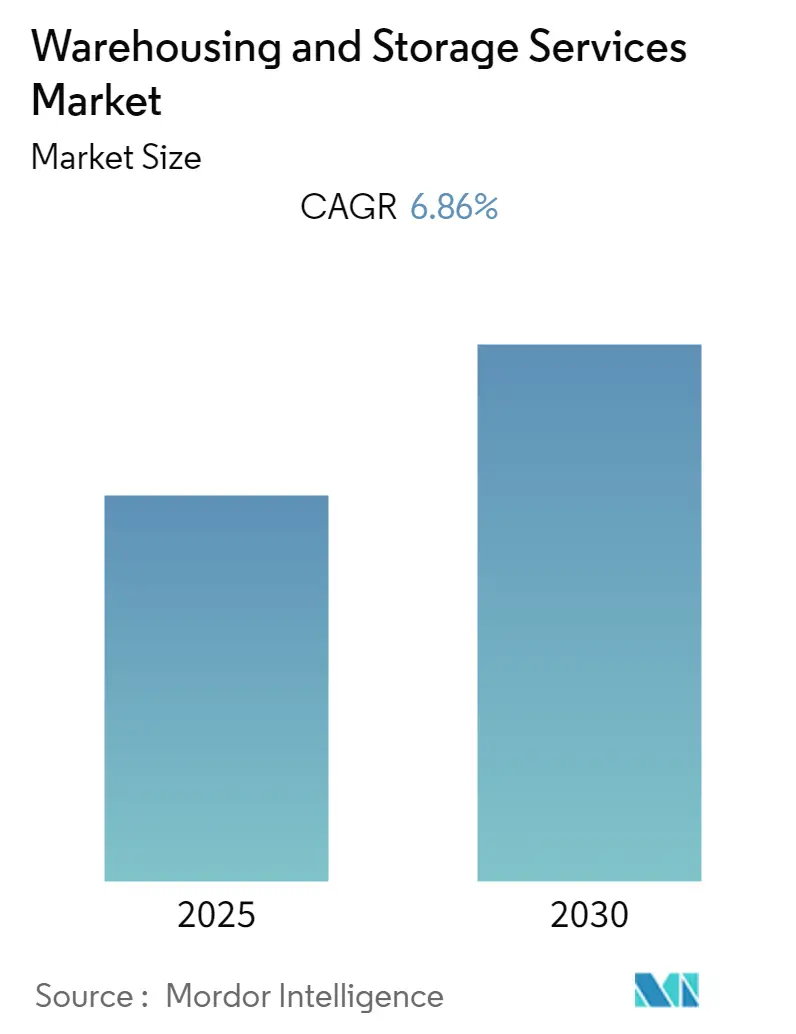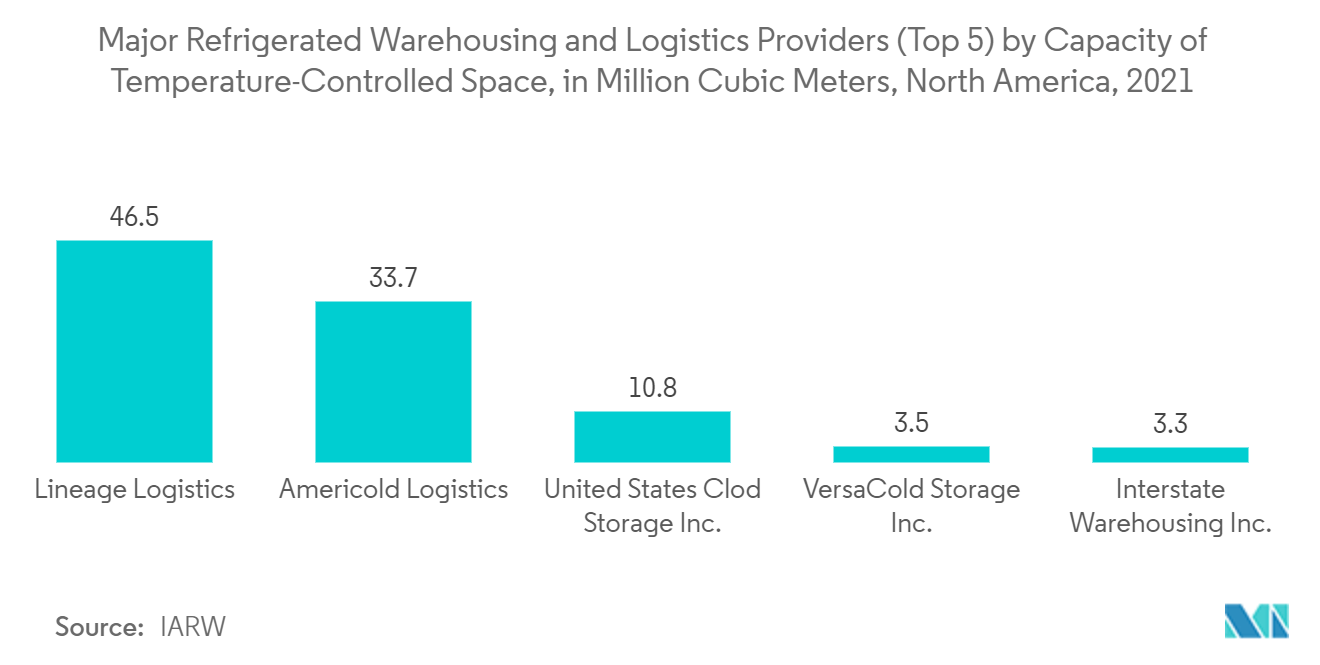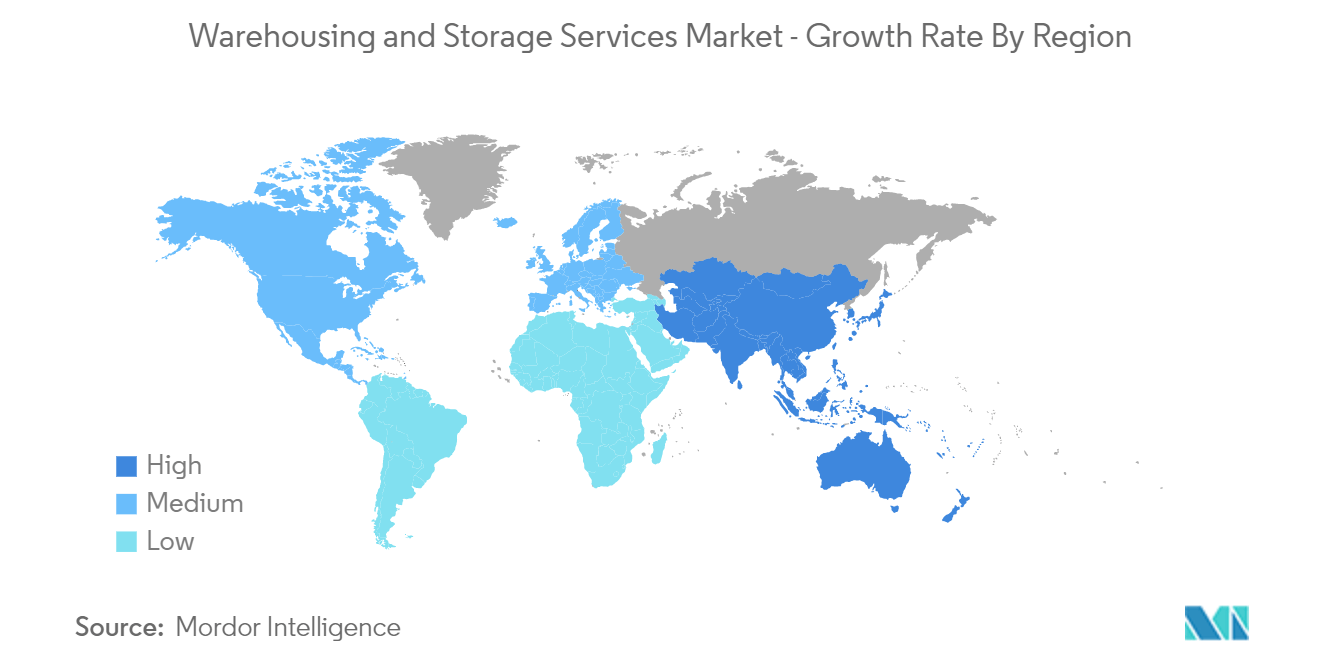Warehousing and Storage Market Size

| Study Period | 2019 - 2030 |
| Base Year For Estimation | 2024 |
| Forecast Data Period | 2025 - 2030 |
| CAGR | 6.86 % |
| Fastest Growing Market | Asia Pacific |
| Largest Market | North America |
| Market Concentration | Low |
Major Players
*Disclaimer: Major Players sorted in no particular order |
Warehousing and Storage Market Analysis
The Warehousing and Storage Services Market is expected to register a CAGR of 6.86% during the forecast period.
The growth of the industrial sector, increasing demand for manufactured products, processed and frozen food products, and the expansion of the e-commerce industry are among the significant factors driving the demand for warehousing and storage services.
- Warehousing and storage services provide storage for another company or organization's property, including parts, equipment, vehicles, products, and perishable goods. The increasing demand for an omnichannel model is expected to drive the market. Although customers embrace the online buying trend, offline stores still hold a significant market share, especially in the big-ticket products segment, such as furniture, which expands the warehouse and storage market.
- With supply chains being reconfigured to meet demand faster than ever, warehouses are increasingly integrating logistics, as logistics services play a crucial role in this process. Additionally, with the globalization trend further expanding its scope, a significant portion of the inventory of industries that operate globally is delivered frequently from abroad to a warehouse to transfer finished goods through the supply chain, which in turn is also driving the demand for warehouse and storage services.
- The growth in demand and requirement to store new product types have significantly impacted the complexity of the warehouse service providers, who now have started to look for innovative technologies that can help them reduce the complexity and provide them with tools to manage the facility better. For instance, Warehouse Management System is one such solution that offers visibility into a business' entire inventory and works supply chain fulfillment operations from the distribution center to the store shelf.
- Furthermore, warehousing/storage service providers are also focusing on optimizing their batching, handling, and picking processes to enhance delivery times further while ensuring the quality of delivery. Such trends facilitate the development of new warehouse construction and management techniques. Additionally, to compete with global players, many vendors are adopting emerging technologies, such as GPS, RFID, VoIP devices, digital voice, and imaging technology for warehouse operations.
- However, the higher investment required to set up warehouses and adopt advanced technologies is among the significant challenges warehouse/storage service providers face. Furthermore, a lack of awareness among SMEs and common global standards also challenges the market's growth.
- COVID-19 resulted in many warehouses running busier than ever, mainly catering to food products, pharmaceuticals, and essential household goods. Amazon, Aldi, Asda, and Lidl have all reported a need to increase their capacities and hire an additional warehouse workforce. Although in some sectors, especially in the industrial and manufacturing domain, the demand declined, especially during the initial phase, the market is expected to recover gradually in the coming years.
Warehousing and Storage Market Trends
The Refrigerated Warehousing and Storage Segment to Grow Significantly
- The refrigerated warehousing and storage facilities deal with products that require refrigerated and controlled rooms for storage. It also refers to where perishable products are stored or kept at low temperatures. Most of these cold storage rooms or refrigerated warehouses are designed with properties that can keep the items within optimum conditions. Establishments in the refrigerated warehousing and storage industry provide services, such as tempering, blast freezing, and modified atmosphere storage services.
- Refrigerated warehousing and storage are showing positive trends toward market growth, mainly in the pharma and food and beverage sectors. The Care Quality Commission recommends that insulins, antibiotic liquids, injections, eye drops, and some creams must be stored between 2ºC and 8ºC to maintain the effectiveness of the medicines. According to the U.S. Census Bureau, 117.45 million Americans used eye drops and eyewash in 2021. This figure is projected to increase to 118 .49 million in 2023. The increasing demand for liquid pharmaceutical products, especially after the pandemic, is expected to impact the market's growth positively.
- Refrigerated storage is integral to Supply Chain Management (SCM) when transporting and storing temperature-sensitive products. New opportunities are also being created by bilateral free trade agreements, such as the North America Free Trade Agreement (NAFTA), which allows vendors in the United States to increase the trading of perishable food products with minimal import duties. Such trade agreements favor the market's growth.
- Considering the growing demand for cold storage warehouses, the vendors operating in the market continuously focus on expanding their footprint. For instance, according to the International Association of Refrigerated Warehouses (IARW), Lineage Logistics was the most extensive refrigerated warehousing and logistics provider in the North American region, with 42,526.06 thousand cubic meters of temperature-controlled space.

North America is Expected to Hold a Major Share
- Several factors also drive the warehousing and storage market in the North American region. An increase in logistics needs for storing raw materials and finished goods for distributors and retailers has been growing as manufacturing companies increasingly outsource warehousing services to focus on productional and operational expansions. Additionally, enhanced operational efficiency and cost savings encourage shippers to outsource the logistics portion of their activities to warehouse service providers.
- The presence of retail and e-commerce giants, such as Amazon and Walmart contributes significantly to the region's demand for warehouse and storage services. According to Walmart, as of 2022, the company uses 31 dedicated e-commerce fulfillment centers and 4,700 stores within 10 miles of 90% of the U.S. population to fulfill online orders.
- According to a survey of U.S. Amazon sellers, the three most significant pain points for sellers in upstream warehousing and distribution operations were complicated fee structures, high prices for storage, and insufficient storage capacity. To address these challenges, vendors are increasingly focusing on developing new business strategies to attract more customers. For instance, in September 2022, Amazon announced new services to enable sellers to use new, purpose-built facilities for bulk inventory storage and automated distribution.
- With significant growth in the manufacturing, retail, and pharma units, the market shows potential growth in the United States. According to the U.S. Department of Commerce, the U.S. warehousing and storage industry's revenue increased to USD 50.49 million in 2021. With vendors continuously focusing on expanding their facilities, such trends are only expected to grow further.
- Furthermore, the adoption rate of new warehouse and storage technologies is expected to remain high in the North American region as the region is among the early adopters of new technologies. Additionally, the required infrastructure heightened awareness, and availability of a skilled workforce are other significant factors supporting such trends.

Warehousing and Storage Industry Overview
The warehousing and storage services market is competitive, mainly because of the presence of several players. The competition is expected to intensify because of the relatively low entry barriers. Long-term partnerships, mergers, acquisitions, and high investments in warehouse management software are the prime growth strategies adopted by companies to sustain the growing competition. Some major players operating in the market include DHL International Gmbh, XPO Logistics Inc., and FedEx Corp, among others.
- September 2022 - GXO Logistics Inc., a leading pure-play contract logistics provider, opened a new warehouse facility with Bayer. GXO will manage warehouse support, including all shipping and receiving activities, for Bayer's Crop Science division through its shared-space distribution network GXO Direct at the new 350,000-square-foot facility in Kearney, Nebraska.
- May 2022 - Vertical Cold Storage, a developer, and operator of temperature-controlled distribution centers acquired three public refrigerated warehouses in Florida, Nebraska, and North Carolina from US Cold Storage. The company made these acquisitions to support its expanding protein business, including poultry, meat, poultry, and seafood.
Warehousing and Storage Market Leaders
-
XPO Logistics, Inc.
-
Ryder System, Inc.
-
FedEx Corp
-
DHL International GmbH
-
NFI Industries, Inc.
*Disclaimer: Major Players sorted in no particular order

Warehousing and Storage Market News
- September 2022 - Amazon.com Inc. introduced a new service to help its sellers tackle supply-chain issues by storing bulk inventory and easing distribution. The new service, called Amazon Warehousing and Distribution (AWD), provides its sellers with a pay-as-you-go service, helping them store and distribute their inventory within Amazon's fulfillment network.
- February 2022 - Amazon India leased a 154,000 warehouse facility in Pune for 20 years from IndoSpace, a real estate and logistics park developer. The company had made this agreement through its subsidiary Amazon Transportation Services. The acquisition is in line with the company's aggressive strategy to expand its warehouse and logistics capabilities in the country.
Warehousing and Storage Market Report - Table of Contents
1. INTRODUCTION
1.1 Study Assumptions and Market Definition
1.2 Scope of the Study
2. RESEARCH METHODOLOGY
3. EXECUTIVE SUMMARY
4. MARKET INSIGHTS
4.1 Market Overview
4.2 Industry Value Chain Analysis
4.3 Industry Attractiveness - Porter's Five Forces Analysis
4.3.1 Bargaining Power of Suppliers
4.3.2 Bargaining Power of Consumers
4.3.3 Threat of New Entrants
4.3.4 Threat of Substitute Products
4.3.5 Intensity of Competitive Rivalry
4.4 Impact of COVID-19 on the Market
5. MARKET DYNAMICS
5.1 Market Drivers
5.1.1 Rising Popularity of Omnichannel Distribution
5.1.2 Growth in the E-commerce Industry
5.2 Market Restraints
5.2.1 High Investment and Maintenance Costs
6. MARKET SEGMENTATION
6.1 By Type
6.1.1 General Warehousing and Storage
6.1.2 Refrigerated Warehousing and Storage
6.1.3 Farm Product Warehousing and Storage
6.2 By Ownership
6.2.1 Private Warehouses
6.2.2 Public Warehouses
6.2.3 Bonded Warehouses
6.3 By End-user Industry
6.3.1 Manufacturing
6.3.2 Consumer Goods
6.3.3 Food and Beverage
6.3.4 Retail
6.3.5 Healthcare
6.3.6 Other End-user Industries
6.4 By Geography
6.4.1 North America
6.4.2 Europe
6.4.3 Asia-Pacific
6.4.4 Latin America
6.4.5 Middle East & Africa
7. COMPETITIVE LANDSCAPE
7.1 Company Profiles
7.1.1 DHL International GmbH
7.1.2 XPO Logistics Inc.
7.1.3 Ryder System Inc.
7.1.4 NFI Industries Inc.
7.1.5 AmeriCold Logistics LLC
7.1.6 FedEx Corp
7.1.7 Lineage Logistics Holding LLC
7.1.8 NF Global Logistics Ltd
7.1.9 APM Terminals BV
7.1.10 DSV Panalpina AS
7.1.11 Kane Is Able Inc.
7.1.12 MSC - Mediterranean Shipping Agency AG
- *List Not Exhaustive
8. INVESTMENT ANALYSIS
9. FUTURE OUTLOOK OF THE MARKET
Warehousing and Storage Industry Segmentation
Warehousing and storage services include storage space for companies' or organizations' property, including equipment, parts, products, and perishable goods. This often includes inventory management and distribution. The proper storage and tracking of inventory ensure delivery times are met, and asset management costs are reduced.
The report offers the market sizes, trends, and forecasts in value for segments by type, ownership, end-user industry, and geography. The scope of the study also includes an in-depth analysis of COVID-19 impact on the warehouse and storage services market. The market sizes and forecasts are provided in terms of value (USD) for all the above segments.
| By Type | |
| General Warehousing and Storage | |
| Refrigerated Warehousing and Storage | |
| Farm Product Warehousing and Storage |
| By Ownership | |
| Private Warehouses | |
| Public Warehouses | |
| Bonded Warehouses |
| By End-user Industry | |
| Manufacturing | |
| Consumer Goods | |
| Food and Beverage | |
| Retail | |
| Healthcare | |
| Other End-user Industries |
| By Geography | |
| North America | |
| Europe | |
| Asia-Pacific | |
| Latin America | |
| Middle East & Africa |
Warehousing and Storage Market Research FAQs
What is the current Warehousing and Storage Services Market size?
The Warehousing and Storage Services Market is projected to register a CAGR of 6.86% during the forecast period (2025-2030)
Who are the key players in Warehousing and Storage Services Market?
XPO Logistics, Inc., Ryder System, Inc., FedEx Corp, DHL International GmbH and NFI Industries, Inc. are the major companies operating in the Warehousing and Storage Services Market.
Which is the fastest growing region in Warehousing and Storage Services Market?
Asia Pacific is estimated to grow at the highest CAGR over the forecast period (2025-2030).
Which region has the biggest share in Warehousing and Storage Services Market?
In 2025, the North America accounts for the largest market share in Warehousing and Storage Services Market.
What years does this Warehousing and Storage Services Market cover?
The report covers the Warehousing and Storage Services Market historical market size for years: 2019, 2020, 2021, 2022, 2023 and 2024. The report also forecasts the Warehousing and Storage Services Market size for years: 2025, 2026, 2027, 2028, 2029 and 2030.
Warehousing and Storage Industry Report
The warehousing and storage market is experiencing significant growth, driven by the expansion of e-commerce, the rising popularity of omnichannel distribution, and the increasing demand for refrigerated storage solutions. This market is segmented based on warehouse types, ownership, and end-use, serving industries like manufacturing, retail, healthcare, and food and beverage. General warehousing dominates, but there's a rising demand for refrigerated warehousing due to the growth in perishable goods. Private warehouses are prevalent, offering tailored storage solutions. Regionally, the market spans North America, Asia-Pacific, Europe, and more, contributing to the global warehousing market size and trends. Innovations in warehouse management systems are enhancing operational efficiencies, shaping warehousing industry trends as a critical component of the global logistics network. For detailed statistics on warehousing and storage services market share, size, and revenue growth rate, access a free report PDF download from Mordor Intelligence™ Industry Reports, which includes a market forecast outlook and historical overview.



